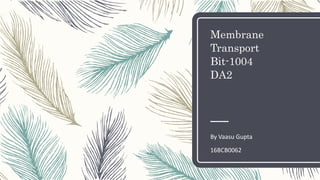
Membrane transport
- 2. Membrane Transport System – Membrane transport system is the transport system by which various molecules enter into and out of cell across cell membrane. Cells have various transport mechanism. Based on whether the molecules pass directly through lipid bilayer or via membrane channel, whether or not the molecules is altered as it passes through membrane , whether or not the process require energy, membrane transport system is categorized into two major groups- – 1)Passive Transport – 2)Active Transport
- 3. Passive transport – Passive transport mechanism does not require cellular energy to transport molecules across cell membrane. So it is a passive process. – In this transport system, molecules are transported from its higher concentration to the lower concentration until concentration gradient is diminished. – Passive transport does not work against concentration gradient. – Passive transport includes- – i) Simple diffusion or passive diffusion – ii) Osmosis – iii) Facilitated diffusion
- 5. Simple diffusion – Simple diffusion is the transport or movement of molecules from higher concentration to lower concentration without expenditure of energy. – In this process, molecules simply diffuses through the pore of cell membrane. – Simple diffusion do not require transporter protein. – When the concentration of molecules is different inside and outside of the cell membrane, concentration gradient is established. Then the molecules moves from higher concentration to lower concentration until equilibrium is maintained. – When the concentration of molecules becomes equal on both side of the membrane, transport process stops. – In some case, the molecules after entering the cell transform metabolically, preventing to build up concentration of transported molecules, hence the concentration gradient remain established. – Examples: water or gases enter the bacterial cell by simple diffusion.
- 6. Osmosis – The movement of solvent (water) across membrane in response to the concentration gradient of solute is known as Osmosis. – Bacterial cytoplasm have generally higher solute concentration than its surrounding. – There are 3 types of solution based on comparison to the bacterial cytoplasmic concentration. – In isotonic solution, water move equally in both direction inside and outside of cell. – In hypertonic solution, water moves out of the cell so that cell shrinks. The process is known as plasmolysis. – In hypotonic solution, water moves inside the cell so that cell swells up. The process is known as plasmotysis.
- 7. Facilitated diffusion – The process of facilitated diffusion is similar to simple diffusion as the molecules flows from higher concentration to lower concentration but it is different from simple diffusion because it requires transporter protein for the process. – The transporter protein is known as Permease or Porter or carrier protein. – The transporter protein are specific however some can transport multiple compounds. – At first solute molecule binds with the transporter protein and changes the 3D structure of the transporter protein and this change in shape allows the solute to carried across the membrane.
- 8. Active transport – Active transport requires transporter protein and continuous supply of cellular energy for the transport of molecules across concentration gradient of the membrane. – Active transport is very important to transport the molecules which are present in very low concentration in the medium. – In active transport permease or transporter protein carries the molecules across the membrane and the energy required to transport is obtained by ATP or Ion gradient. – The substances transported by active transport are glucose, aminoacids, organic acids and inorganic ions (SO4–, PO4–, K+ etc). – Examples: Lac operon (transport of lactose in E. coli), Na-K pump
- 9. – Active transport system includes- – i) Primary active transport – ii) Secondary active transport
- 10. Primary Active Transport – Primary active transport utilizes energy in form of ATP to transport molecules across a membrane against their concentration gradient. Therefore, all groups of ATP-powered pumps contain one or more binding sites for ATP, which are always present on the cytosolic face of the membrane. – Based on the transport mechanism as well as genetic and structural homology, there are considered four classes of ATP-dependent ion pumps: – P-class pumps – F-class pumps – V-class pumps – The energy expended by cells to maintain the concentration gradients of some ions across the plasma and intracellular membranes is considerable: – In kidney cells, up to 25 % of the ATP produced by the cell is used for ion transport
- 11. Secondary Active Transport – Secondary active transport, is transport of molecules across the cell membrane utilizing energy in other forms than ATP. This energy comes from the electrochemical gradient created by pumping ions out of the cell. This Co-Transport can be either via antiport or symport. – Example : Na+ / glucose co-transporter – The formation of the electrochemical gradient, which enables the co-transport, is made by the primary active transport of Na+. Na+ is actively transported out of the cell, creating a much higher concentration extracellularly than intracellularly. This gradient becomes energy as the excess Sodium is constantly trying to diffuse to the interior. This mechanism provides the energy needed for the co-transport of other ions and substances. This is evident in co-transporters such as the Sodium-glucose co-transporter. The Na+ gradient created by the Na+/K+ ATPase is used by the Na+/Glucose co- transporter to transport glucose and Na+ back into the cell.